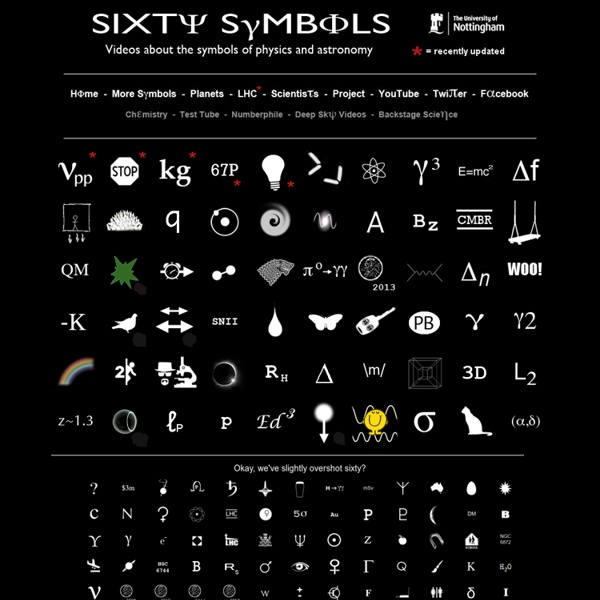



The Elegant Universe: Pt 1 The Elegant Universe: Part 3 PBS Airdate: November 4, 2003 NARRATOR: Now, on NOVA, take a thrill ride into a world stranger than science fiction, where you play the game by breaking some rules, where a new view of the universe pushes you beyond the limits of your wildest imagination. This is the world of "string theory," a way of describing every force and all matter from an atom to earth, to the end of the galaxies—from the birth of time to its final tick, in a single theory, a "Theory of Everything." Our guide to this brave new world is Brian Greene, the bestselling author and physicist.
Physics Flash Animations We have been increasingly using Flash animations for illustrating Physics content. This page provides access to those animations which may be of general interest. The animations will appear in a separate window. The animations are sorted by category, and the file size of each animation is included in the listing. Also included is the minimum version of the Flash player that is required; the player is available free from The categories are: Einstein for Everyone Einstein for Everyone Nullarbor Press 2007revisions 2008, 2010, 2011, 2012, 2013 Copyright 2007, 2008, 2010, 2011, 2012, 2013 John D. Norton Published by Nullarbor Press, 500 Fifth Avenue, Pittsburgh, Pennsylvania 15260 with offices in Liberty Ave., Pittsburgh, Pennsylvania, 15222 This Will Mindfuck You: The Double-Slit Experiment The video below shows scientific proof that there is something NOT quite logical or scientific about this universe. The mere act of observation can completely change the outcome of an event! Before I get too ahead of myself, you need to watch the video below to understand:
The Large Hadron Collider The Large Hadron Collider (LHC) is the world’s largest and most powerful particle accelerator. It first started up on 10 September 2008, and remains the latest addition to CERN’s accelerator complex. The LHC consists of a 27-kilometre ring of superconducting magnets with a number of accelerating structures to boost the energy of the particles along the way. Problem of Reciprocity Back to main course page John D. Norton Department of History and Philosophy of Science University of Pittsburgh US LHC Blog » But what are quarks made of? Part 2 Hello, again. Thanks for all the excellent comments on my last post. In my last post I explained that our current theory makes the assumption, which has not been experimentally verified, that quarks are indivisible, point-like particles (“elementary” particles).
Special Relativity Special Relativity These pages are ok as far as they go, but they are missing the planned highlight, to show you what things actually look like when you travel at near the speed of light. I hope to have the opportunity to develop these pages further as time permits. Here is my opinionated Guide to Special Relativistic Flight Simulator Sites. Meanwhile, these pages comprise an animated introduction to the elements of Special Relativity. Antimatter caught streaming from thunderstorms on Earth 11 January 2011Last updated at 08:34 By Jason Palmer Science and technology reporter, BBC News, Seattle Electrons racing up electric field lines give rise to light, then particles, then light A space telescope has accidentally spotted thunderstorms on Earth producing beams of antimatter.
10 Strange Things About The Universe Space The universe can be a very strange place. While groundbreaking ideas such as quantum theory, relativity and even the Earth going around the Sun might be commonly accepted now, science still continues to show that the universe contains things you might find it difficult to believe, and even more difficult to get your head around. Theoretically, the lowest temperature that can be achieved is absolute zero, exactly ?
Quantum Computer Simulates Hydrogen Molecule Just Right Almost three decades ago, Richard Feynman — known popularly as much for his bongo drumming and pranks as for his brilliant insights into physics — told an electrified audience at MIT how to build a computer so powerful that its simulations “will do exactly the same as nature.” Not approximately, as digital computers tend to do when facing complex physical problems that must be addressed via mathematical shortcuts — such as forecasting orbits of many moons whose gravities constantly readjust their trajectories. Computer models of climate and other processes come close to nature but hardly imitate it.
Physics Flash Animations We have been increasingly using Flash animations for illustrating Physics content. This page provides access to those animations which may be of general interest. The animations will appear in a separate window. The animations are sorted by category, and the file size of each animation is included in the listing.